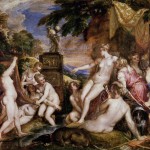Between 1553 and 1562, Titian painted a number of mythological scenes for Philip II. Among these was a painting of Diana and Callisto. In the story, told most famously by the Roman poet Ovid, Callisto is one of the unmarried girls forming the virgin goddess’s entourage. Jupiter catches sight of her, and disguises himself as Diana so she won’t be alarmed (this in itself is a very interesting comment on how the entourage works – Callisto is not remotely alarmed when the fake ‘Diana’ kisses her). He then rapes her and makes her pregnant. Callisto manages to cover up her pregnancy for 9 months, but then Diana suggests all the girls go skinny-dipping. Callisto tries to keep her clothes on, but the other girls strip her to reveal her advanced pregnancy. Diana bans her from the group. When Callisto gives birth, Jupiter’s wife Juno – jealous at Jupiter’s infidelities – turns her into a bear. 15 years later, Callisto spots her human son out hunting and approaches him. He, of course, sees this as a bear coming towards him and is about to kill her when Jupiter takes her up into the heavens and makes her into a constellation – the Great Bear.
Titian’s painting shows Callisto’s tear-stained face in shadow, her contorted body contrasted with Diana’s queenly pose. The way the other girls are holding her body down recalls the start of her pregnancy in an act of rape. The painting can now be seen with the two paintings of Diana and Actaeon in London at the National Gallery’s current exhibition, ‘Metamorphosis: Titian 2012′, in which modern artists respond to Titian.
The National Gallery asked me to talk about this painting for an exhibition podcast (Podcast 70, August 2012 – also featuring the late Ted Hughes!) because I’ve worked on the goddess Artemis/Diana. Standing by the painting for the best part of an hour, I found myself thinking about the medical ideas behind it. In the 1550s, ideas about women’s bodies were very much rooted in ancient Greek medicine. Sixteenth-century medical writers were interested in questions which, to us, seem rather odd: did Amazons menstruate? could a girl become pregnant before she had had a menstrual period?
One ancient theory was that menstrual blood was produced from normal food and drink, building up in the body over the month, and acting as the raw material out of which a baby would be made. So it was theoretically possible to have accumulated enough blood in just the first month of a girl’s ‘ripeness’ for her to make a baby, if the male seed happened to enter at that point. To us, Diana’s treatment of Callisto seems most unfair – it wasn’t her fault that a god raped her. But perhaps there is something more going on here – perhaps she should have opted out of Diana’s entourage because her body was actually mature enough to contribute to making a baby.
It’s also important to think about what this painting meant to Philip II, who seems to have liked these images not just as ways to show off his knowledge of ancient myths, but also for the opportunities they gave to look at naked women. In particular, there’s a girl behind the abject Callisto who has one breast exposed. And Callisto’s clutching hand is so close to it that to a male viewer at Philip’s court it would have suggested his own hand on that breast. It’s interesting here that in the companion painting of Actaeon seeing Diana taking a bath, Titian seems to show him revealed as peeking at her from behind a curtain, rather than coming upon her completely by accident, as the ancient myth would suggest. For Philip, these were images of a goddess punishing mortals simply because she can: they therefore had something to say about his own kingly power. But the images also said something about the secrets of the female body and male curiosity concerning what was really going on in there. Apparently, Philip kept curtains over these paintings when his wife was around…!

